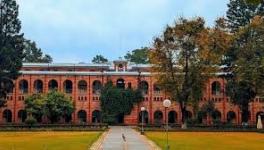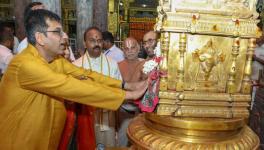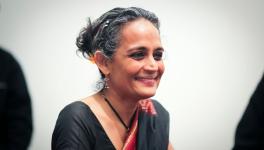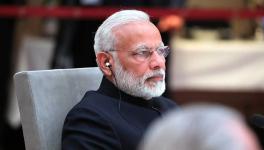Tracing Bhotiyas' Journey From Tribal to Caste Hindu Identity

Damyanti sits by her pitloom. | Image credit: Kushal Choudhary and Govind Sharma
Damyanti Pankti is a weaver of traditional shawls, belonging to the famous village of Darkot. A village in Munsiyari tehsil of Uttarakhand, the shawls, carpets and other small woollen articles weaved exclusively by the Bhotiya tribal community of the region, are a significant part of Bhotiya culture and one of the many traditional ways of life the Bhotiyas have led for decades in the Kumaon region of Uttarakhand.
“The work of weaving has been done by our ancestors for a long time. They used to do weaving and farming for a livelihood,” says Hansa Pankti, another woman who weaves shawls. The village consists of many households who engage in weaving, predominantly run by women of the community.
“Bhotiyas in our village all possess a pit loom (a type of handloom) and engage in this work. It has been our traditional business,” says Damyanti. She currently weaves a shawl from angora rabbit fur, and says that the culture of weaving has changed a lot over several years. “Since the old times, we have changed our way of weaving a lot. We used to have simpler designs and now we make more efforts towards many patterns. We also used to make it with the wool of sheeps and goats,” she says. Pointing to the fairly new usage of Angora rabbits, she says, “Now we mostly work with angora rabbit fur and pashmina, which comes from Tibet."

Hansa shows a shawl made of angora fur. | Image credit: Kushal Choudhary and Govind Sharma
The Bhotiyas have remarkably preserved much of their way of life and also progressed through a vibrant political and cultural history. Presently, in Darkot, Tanuja Pankti, another weaver woman, says that almost all households work with the looms and also have people who have private or government jobs. “We profit from the work as well, and now the community is more inclined towards education and finding better employment,” Tanuja said. She suspects that maybe in the future they may face a decline in the tradition of weaving, but currently its mostly a profitable business for the Bhotiyas.
In Munsiyari, roughly 20% of the population consists of the Bhotiyas. “An almost equal percentage of the SC population lives here. Rest are of the general castes,” says Ram Narayan, an ecologist and activist working in Munsiyari for the past 25 years. He suggests that the small population doesn’t represent a minority social condition. Bhotiyas compromise the elites in the region.
“The STs are the dominant community over here. This is perhaps because the traditional Hindu caste system doesn't work over here. STs, whatever their origins, 100 years ago they were separated from the Hindu milieu, then they converted to Hinduism. They took help of pandits from Bageshwar to Sanskritise themselves,” Ram said. Today, many people from this community from other villages of Munsiyari, such as in Sarmoli, run businesses such as shops, hotels and homestays in Munsiyari as well. Thus, with their hands in both traditional and modern occupations, they seem to be a dominant community in Munsiyari.
A broader historical look of the community tells us of a complex history of ever-changing culture and politics of the community vis-a-vis Hinduism and modernisation.
CONTESTARIONS IN A CASTE, HINDU POSTCOLONIAL SOCIETY
Scholar Christopher Bergmann writes of the Bhotiya community’s attempt at presenting their vibrant and distinct culture to the Indian state post independence, and all the while making grounds to claim a backwardness in a modernising society. The Kumaon Bhotiya People’s Federation (KBPF) advocated for the cause of the Bhotiya community, demanding “special statutory safeguards as well as constitutional protection for the Bhotiya community as a minority. The Federation consisted of a powerful elite that had already amassed a considerable amount of cultural capital under British rule, especially by having accessed educational institutions and offices in the public sector,” writes Bergmann.
They submitted a report to the Indian Minority Sub-Committee in 1947, a few months before Indian independence, providing details of their history and culture. The report said:
"[...] it can be observed that the Bhotiyas of Kumaon are still in the lower rungs of the cultural evolution. It is because of the fact that environment is still dominant with its strong impress not only upon their social economy but also upon their religious ceremonies, festivals and social practices. But there is no denying the fact that tremendous difficulties of environment have not, as it might be imagined, been able to suppress the initiative and energy of the Bhotiyas. On the other hand they have possessed a high degree of adaptive skill and uncommon physical vigour."
One of the key arguments to showcase the will and mobility of the Bhotiya community towards Hindu society was to present the fact of Hinduisation.
“At the present moment the Bhotiyas of Garhwal , Johar, Darma, Bians [sic] and Chaudas [sic] have almost been Hinduised, though some of them have their own tribal religion and social practice. It was on account of these facts that Missionaries many years before tried to convert them to Christian faith, but it was vehemently resisted. They better preferred to adopt the Hindu faith of the socially higher groups of Kumaon of their own accord."
The process of Hinduisation must have been taking place for decades upto this point, but tribal ethnic culture of Bhotiyas too needed to be presentable to the emerging modern Indian nation state and the mainstream Hindu society that the Bhotiya elites were in much in favour. That to prove both a certain ‘tribalness’ and a Hinduised community fit for participating and contesting in Hindu society, was a complex path to be taken through enacting reform for the Kumaoni Bhotiya community and reconfiguring some of the traditional roles of women.
Bergmann notes, “It was this question (the question of resolution of the women’s question’ in postcolonial India), or the control over women, that emerged as a key representational trope when the members of the KBPF articulated their demand for special statutory safeguards and constitutional protection as an ethnic minority.”
While many observers and scholars would note that tribal communities such as the Bhotiyas were communities that inculcated greater freedom in terms of choice of marriage, better say in domestic affairs, major roles in the traditional economy of trade and farming, one of the most controversial and debated cultural trope, both among oriental and Indian scholars, was the practice of rambang. It was practised among a sub-group of the Bhotiyas, namely the Darmanis, belonging to the Darma valley, while other Bhotiya sub-groups such as the Johari Shaukas seems to have left it long ago, even before the intervention of the British in Kumaon. Bergmann notes that the practice of rambang was considered disreputable by many emerging representatives of Bhotiya people. The cultural practice of rambang involved free intermingling between Bhotiya women and men. Young boys and girls would spend nights in village clubs and were said to be engaged in drinking, mingling, and other recreational activities. Many oriental commentators though usually in awe of better standing of women in Bhotiya tribal society could only see such an interaction as an affront to the modesty of women. A colonial commentator wrote:
“As is to be expected, a system such as this leads to the freest intimacy, and one sees a man walking about with his arm round a girl’s waist both under the same covering shawl, a practice common in Europe but rare in the East: modesty is unknown and there is a boldness in the faces of women. Intentional miscarriages of illegitimate children are not at all uncommon.”
Another asserted:
“Each village has two or three Ramang [sic] houses, i.e., clubs belonging to the girls of the village, where they spend their nights together, instead of sleeping in their own homes. To these houses resort the young, or even married, men, generally of other villages.The night is spent in spinning, singing, drinking and laughing and joking till overcome by sleep. The evils of this custom are beyond estimation, and one will readily believe there is very little virtue in Bhot.”
Such negative portrayal of the tradition set the grounds for the KBPF to make a case for “the uneven success of the different valley communities in keeping pace not only with the process of Hinduisation – as it was before – but also with the formation of a modern Indian nation.” notes Bergmann. Thus, to cater to a unified Hinduness, and by that virtue a modernity was to be catered as well among the Bhotiyas, the KBPF called for a modernist reforms against such “evils of ignorance”:
“Under these circumstances, the spread of education among the Bhotiyas of Kumaon is the only hope through which the evils of ignorance can be banished and people made to realise their duty not only towards themselves but also towards their society as a whole. At this stage, it is the duty of the Govt. and public men that the evil practices of the Bhotiyas are abandoned through education and if necessary through legislation.”
Thus, the practice of rambang provided a context of backwardness and claimed to necessitate reform through the intervention of the modern Indian state. The intervention so desired was essentially to control women’s agency, and make it favourable to a caste Hindu society, that is favourable to the modest womanhood practised by the upper caste Hindus of Kumaon.
The Darmani group remained much in isolation for the coming decades, they were considered lowly and were not as well off as the other counterparts such as the Johari Shaukas, even after Indian independence. While Bhotiyas were enlisted under the Scheduled tribe category in 1967 which “guaranteed them quota-access to universities, government services and the legislature, amongst other privileges,” the economic backwardness of the group remained. Ram Narayan says that “there was very less interactions between these communities, until the 2000s, when keera ghas was discovered.”, notes Bergmann. Keera ghas, or yartsa gunbu is a fungus that grows on dead insects, and has many medicinal properties. It has become a stable trade among many communities who migrate towards Tibet and the Himalayas to harvest it. “Overnight, the Darmia community too became rich and it became feasible for intermarriages to start happening over time. They could now migrate to other parts of Kumaon and beyond when they became economically better off through the whole harvesting of keera ghas from the alpines.”
Keera ghas became an economic leveller for the Darmanis and put them on a similar level as the dominant Johari Shaukas. “Keera ghas post 2000s, boosted the economy. Usually those who went to collect medicinal plants in the alpine areas would earn the bare minimum to survive. For a period of 10-12 years, keera ghas’ price went from being Rupees 10-12k per kg to a few lakh rupees per kg. Many families migrated to the alpines for a few months, regardless of caste or tribe and the Darmais were also a part of this massive gold rush. They could now pay off debts and have a sense of economic security,” Ram Narayan adds. In general, all Bhotiyas and other communities who harvest Keera ghas benefitted massively.
CASTE HINDUS MOBILISE FOR REPRESENATION
While the Bhotiyas have seemed to enjoy benefits of state intervention post their enlistment as a scheduled tribe, they have already been landlords through the British era. Bergmann notes that “already under British colonial rule Bhotiyas had acquired respectable landholdings around their winter settlements and along their migratory route toward the Terai. Since trans-Himalayan trade and seasonal migration made it difficult for them to make use of their landed property during a large part of the year, they installed non-migratory (and often high-) caste Hindus as tenants in these places.”
The caste Hindus thus have always felt disadvantaged, though they have been landowners traditionally as well in the hills. Especially when the Bhotiyas were entitled a Scheduled Tribe and could benefit from the state reservations, they collectivised under the a single banner in an environment of conflict when the movement for Uttarakhand statehood was in full swing, and the much awaited implementation of the Mandal Commission was completed under the Mulayam Singh Yadav’s state government of Uttar Pradesh. While in the plains, the reservations for the OBCs was welcomed by the massive Shudra population, the hills didn’t have such a strong demography of the OBC castes. Uniquely, the hills consider many of the Shudra castes such as Ordh, Lohar, Tamta as untouchables, and they are provided with Scheduled caste reservations. An account of the dalit struggle in the district of Pithoragarh can be found here.
The tensions in the 1990s were built along the lines of an apparent elitism of the Bhotiyas who have received state-support since ‘67, challenged by the caste Hindus, who demanded that they too must be considered under the demographic of ‘Bhotiya’, that Bhot is an identity grounded in a geographical location, which can roughly be considered the parts of Kumaon which have historically traded with parts of TIbet.
But this obviously was a farce, and actually hypocritical of the caste Hindus to claim the Bhotiya identity. As Bergmann accurately notes, “In earlier times the ritually established trade partnerships (with Tibet) served the Bhotiyas to strengthen their lucrative commercial monopoly vis-à-vis caste Hindus. While these partnerships had lost their economic importance even before the Sino-Indian border war in 1962, they are nowadays again doomed significant – especially on stage – for another reason: they foreground an ethnographic understanding of the name ‘Bhotiya’, allowing the people whom the state has recognised as such to connect themselves with a common past that is not at all considered disreputable, as it was the case with regard to rambang , but rather celebrated and experienced as a source of pride.”
All the while, caste Hindus looked down upon such relations throughout history, they now wanted to lay claim to the same history. Agitations and cases in court to demand such a status were mostly in vain, and in August 2012, the Lok Sabha discussed some of the large number of proposals to for the “inclusion of specific castes or tribes into the list of Scheduled Tribes, submitted from individual states to the Union government over the last 3 years.” Bergmann notes. ‘Bhotiya Brahmin’ and ‘Bhotiya Rajput’ have been proposed categories.
While the traditional Hindu caste system is not practised in the form of chaturvarna, Kumaon society uniquely discriminates against Dalits, who mostly belong to the Shudra castes, such as Ordh, Lohar, Tamta, etc. This is still prevalent, as has been historically so as well. While SCs have been trapped under feudalism of both the caste Hindus and Bhotiyas, they too were uplifted through state-mandated policies. Though, the rural Kumaoni society still considers them untouchables. One SC resident in Munsiyari told us that he has been disallowed to eat in the common plates and from entering the small place of worship in the hotel he works at.The hotel is run by a Bhotiya couple. “I don’t know why they do something like this, but I have seen it in my village as well,” the informant added. Such instances are not uncommon and SCs remain the population that are structurally backward and discriminated against, while through a history of contestation within Hinduism, the Bhotiyas have triumphed to become a dominating group in Munsiyari and beyond.
The writers are freelance journalists.
Get the latest reports & analysis with people's perspective on Protests, movements & deep analytical videos, discussions of the current affairs in your Telegram app. Subscribe to NewsClick's Telegram channel & get Real-Time updates on stories, as they get published on our website.
























